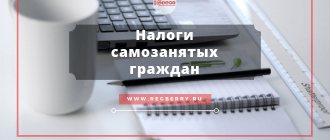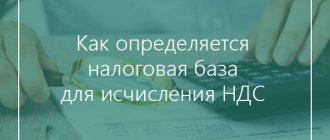Incoming and outgoing VAT
Input VAT is the VAT that sellers of goods (work, services, property rights) charge you and which you, as a buyer or customer, pay.
That is, input VAT appears for those who purchase something from VAT payers, provided that these transactions are subject to VAT. It also appears for those who pay tax when importing goods into the territory of the Russian Federation. By the way, input VAT is also called input VAT. Output VAT is a tax that you charge and bill to your counterparties when selling goods (work, services, property rights), that is, you act as a seller (supplier, performer). VAT payers are required to charge VAT. The accrued VAT must be paid to the budget at the end of the quarter on time. But first, it can be reduced by deductions, namely input VAT (clause 1 of Article 173, clauses 1, 2 of Article 171 of the Tax Code of the Russian Federation).
The essence of the concepts
Input VAT , also called input VAT, is incurred by those who buy something. That is, you, being a VAT payer, purchasing goods and receiving invoices for them, pay input VAT, which can then be deducted from the output tax when settling with the state budget.
Input VAT is generated at the entry of goods into the organization at the time of receipt of an invoice for the goods and its payment. You, as a buyer and taxpayer, pay the input VAT, and it is presented to you by sellers and distributors of goods or services and works provided.
output VAT to your clients when providing them with goods, services or work. When selling an object of VAT taxation, on which the payer calculates the tax amount, you issue an invoice, which indicates the output VAT.
Output VAT must be paid by the taxpayer for a certain tax period. The amount of input VAT may be deducted from it, thereby reducing the amount of tax paid to the budget by the taxpayer.
If suddenly you are provided with an advance on an advance invoice for the upcoming shipment of goods, then the amount of VAT is paid from it, and then subject to deduction after receiving the entire amount on the final invoice.
When is input VAT deductible?
Input VAT is involved in calculating the amount of VAT payable: for payers of this tax, incoming VAT is deducted from the amount of output VAT (clause 1 of Article 173 of the Tax Code of the Russian Federation). But this is only possible if a number of conditions are met:
- goods, works, services, property rights (hereinafter referred to as goods) were purchased for use in transactions subject to VAT (clause 2 of Article 171 of the Tax Code of the Russian Federation);
- purchased goods are accepted for accounting;
- the buyer has an invoice from the supplier and primary documents;
- 3 years have not elapsed since the goods were accepted for registration (clause 1.1 of Article 172 of the Tax Code of the Russian Federation).
As a general rule, when purchasing goods on the territory of Russia, for deduction purposes, it does not matter whether they were paid for or not (Letter of the Ministry of Finance dated June 21, 2013 N 03-07-11/23503). But if an organization paid VAT at customs when importing goods into the territory of the Russian Federation, or when performing the duties of a tax agent for VAT, then it can only accept it for deduction if it has a document confirming its transfer to the budget (clause 1 of Article 172 of the Tax Code of the Russian Federation) .
When can VAT be deducted?
Input VAT
is included in tax deductions only if the following legally established conditions are met:
- mandatory presence of a correctly completed invoice;
- acceptance of the supplied goods (works, services) for registration and use in activities subject to VAT.
In addition, for certain cases there is an additional condition - direct payment of VAT on goods supplied (for example, for tax agents).
If the above requirements are met, invoices with the incoming VAT amount are registered in the purchase book and taken into account in the 3rd section of the VAT tax return.
When input VAT cannot be deducted
Input VAT cannot be deducted if (clause 2 of Article 170 of the Tax Code of the Russian Federation):
- the buyer is not a VAT payer;
- goods were purchased for use in activities not subject to VAT, or for operations the place of sale of which is not recognized as the territory of the Russian Federation.
Then this input tax is taken into account in the cost of purchased goods or as a separate expense (Clause 2, 5, Article 170 of the Tax Code of the Russian Federation). Other cases when tax can be taken into account in the cost of goods are indicated in paragraph 2 of Art. 170 Tax Code of the Russian Federation.
Input VAT accepted for deduction - what is it?
Art. 172 of the Tax Code of the Russian Federation requires compliance with several conditions:
- there is an invoice issued in accordance with current legislation;
- goods (works, services) are registered;
- in cases specified by law, VAT has been paid (tax agent, customs VAT);
- in the future it is assumed that the goods will be used in transactions subject to VAT.
Read more about the conditions for deducting VAT in this article.
If the specified conditions are met, the taxpayer has the right to deduct input VAT by posting D-t 68 K-t 19. After which this invoice will be registered in the purchase book, and the VAT amount will be included in section 3 of the VAT return.
Incoming and outgoing VAT: calculation example, documents
VAT is recognized as one of the main taxes collected in the Russian Federation, whose share in the federal budget accounts for a third of taxpayers’ revenues. At the same time, not all entities are required to pay tax. Others periodically have difficulties with the completeness and accuracy of calculations. When calculating VAT, it is important to reflect the tax in the documents presented to customers and to store incoming invoices from suppliers, which give the right to reduce part of the tax when making payments to the budget. In the article we will consider VAT payers, incoming and outgoing VAT, accounting entries for VAT.
VAT payers
The category of persons whose responsibilities include calculating tax are considered to be organizations and individual entrepreneurs on OSNO engaged in the sale of goods and services within the Russian Federation. These entities are recognized as payers of indirect tax.
A number of organizations and entrepreneurs whose work meets the following conditions are exempt from the need to transfer VAT to the budget:
- preferential tax regimes;
- tax exemption related to low turnover;
- sales of goods and services that are legally exempt from the need to charge VAT;
- sale of goods outside the country.
There is also a need to pay VAT as an indirect payment when importing materials and valuables into the territory of the Russian Federation. In such situations, taxation is carried out at a rate of 0%. Later, buyers independently calculate the tax on the goods received and pay it to the budget. Under these conditions, payers are all entities, regardless of the type of work, the applied taxation regime and total income.
Input VAT under simplified tax system
According to paragraph 2 of Art. 346.11 of the Tax Code of the Russian Federation, taxpayers using the simplified taxation system are not VAT payers - the only exception is the payment of VAT when importing goods into the territory of the Russian Federation and the purchase of goods (work, services) within the framework of a simple partnership (Article 174.1 of the Tax Code of the Russian Federation). Input VAT reflected in invoices when purchasing goods (works, services) is taken into account by simplifiers as expenses - this is provided for in clause 8 of Art. 346.16 Tax Code of the Russian Federation.
Find out more about how to take into account input VAT under the simplified tax system here.
Incoming and outgoing VAT: formula for calculating VAT payable
The formula for calculating VAT payable to the budget is simple. To do this, the amount of incoming tax is subtracted from the amount of outgoing tax, including the actual VAT on import transactions.
VAT (U) = VAT (I) ― VAT (B)
where VAT (U) is the tax payable; VAT (I) is an outgoing tax imposed on customers; VAT (B) - input VAT received from suppliers.
Example of calculating incoming and outgoing VAT
Example. The Romashka organization purchased a batch of materials abroad in June for the amount of 30,000 rubles. I paid 18% VAT on the import of goods (5,400 rubles) in July, and in the same month received confirmation from the INFS of payment. The purchase of domestic raw materials and services in the 3rd quarter amounted to 127,440 rubles, including 18% VAT of 19,440 rubles. Goods were sold to customers in the amount of 371,700 rubles, including VAT 18% of 56,700 rubles. Advance amounts were received from buyers in the 3rd quarter for the upcoming shipment - 20,000 rubles, VAT of 18% was charged on the advance payment - 3,600 rubles.
Outgoing VAT is 56,700 +3,600 = 60,300 rubles, incoming VAT is 5,400 + 19,440 = 24,840 rubles. The tax to be transferred amounted to 60,300 – 24,840 = 35,460 rubles - this amount must be paid to Romashka LLC based on the results of the 3rd quarter.
The client asks me to work with VAT. Why is this important to him?
It's all about input VAT, which can be deducted.
Output VAT is the VAT that a company charges when selling its services and goods. This is what she must pay.
Input VAT is the VAT invoiced by the suppliers of this company. It can reduce its output VAT by the input VAT. This is called VAT deduction.
As a result: the more a company buys on OSNO including VAT, the less VAT it needs to pay. Entrepreneurs using the simplified tax regime do not charge VAT at all, which means that they will not be able to receive a deduction. That's the whole secret.
Anya has a store with healthy food products. A pack of protein bars costs 1,440 rubles, including VAT 240 rubles. Anya bought bars for 1,152 ₽, including VAT 192 ₽, which she can deduct. As a result, she will pay only 48 ₽ VAT (240 - 192).
If Anya had purchased the bars from a supplier without VAT, she would have paid the entire 240 ₽ tax.
Invoices help you track how much incoming VAT you have and how much outgoing. At the end of the period, entrepreneurs, roughly speaking, add up VAT from outgoing invoices and subtract VAT from incoming ones.
VAT documents
Business transactions of entities related to the conduct of activities must be documented. Tax calculations are no exception. Particular attention should be paid to documents on input VAT, since if invoices are missing or incorrectly executed, the inspectorate has the right to refuse the deduction, which will lead to an increase in the final amount of the transfer and penalties.
Incoming and outgoing VAT: confirmation documents
The table below presents documents for incoming and outgoing VAT.
What is VAT. The essence of value added tax
The easiest way to understand what VAT and what the essence of value added tax is is to consider a specific example.
First, let's define what added value . For example, an organization purchased a certain product for 100 rubles and sold it for 300 rubles. In this case, the added value is 200 rubles. (300 rub. – 200 rub.).
Example 1 – The essence of VAT
The Alpha company produces metal, which it sells to the Beta company for 100 rubles plus VAT. The Beta metal company produces metal structures and sells them wholesale to the store for 300 rubles plus VAT. The store, in turn, sells these structures to citizens for 800 rubles, also plus VAT.
The added value is:
- From the Alpha company - 100 rubles
- The Beta company has 200 rubles (300 – 100)
- At the store – 500 rubles (800 – 300)
VAT is equal to the product of value added and the tax rate (18%):
- The Alpha company has 100 rubles * 18% = 18 rubles
- Beta company – 200 rubles * 18% = 36 rubles
- At the store – 500 rubles * 18% = 90 rubles
It is these amounts that each company and store must transfer to the budget.
But this method of calculating VAT is not used in practice, because it is quite complex. Therefore, VAT is calculated either in one stage or in three.
Stage 1 - Output VAT
At this stage, the so-called “outgoing” VAT , i.e. VAT, which is charged on all sales revenue. In accounting, this amount is reflected in the credit of account 68 “Calculations for taxes and fees” (sub-account “VAT”).
From the conditions of our example it is clear that the “outgoing” VAT on revenue will be equal to:
- The Alpha company has 18 rubles (100 rubles * 18%)
- The Beta company has 54 rubles (300 rubles * 18%)
- At the store – 144 rubles (800 rubles * 18%)
Stage 2 - Input VAT
At this stage, the so-called “input” VAT , i.e. VAT, which is paid to suppliers of goods. In accounting, this amount is reflected in the debit of account 19 “Value added tax on acquired assets.”
VAT calculations
To calculate VAT, accounting accounts 19 “VAT on acquired values” and 68 “Calculations for taxes and fees” subaccount “VAT” are provided.
When material (or intangible) assets arrive, the following entries are made. postings to VAT accounts
Dt 19 Kt 60 (76) – reflection of “incoming” VAT from the supplier.
Based on the invoice, the amount of tax recorded on account 19 is debited to account 68
Dt 68 Kt 19
When selling products, works and services to customers, the company issues VAT invoices. The accounting records the following entry for VAT calculation:
Dt 90 (VAT subaccount) Kt 68.
How is VAT taken into account when importing goods from Belarus? When does a company need to restore its accounting records?
At the end of the reporting period, account 68 (VAT sub-account) reflects the balance, which shows the organization’s tax debt.
When transferring taxes to the budget, the following entry is made:
Dt 68 (VAT subaccount) Kt 51.
The legislation sets the deadline for paying VAT - the 20th day of the month following the reporting quarter.
If the tax is not paid by this date, then from the next day late fees will be charged in the amount of 1/300 of the refinancing rate per day.
Tax penalties do not reduce the tax base, since they are not included in the accepted income tax expenses
The accrual of VAT penalties is done as follows:
Dt 99 (sub-account “Accrued penalties”) Kt 68 (sub-account “VAT”, analytics - accrued penalties).
When a penalty is paid, a posting is made
Dt 68 (VAT sub-account, analytics - accrued penalties) Kt 51.
VAT formula
“Output VAT” - “Input VAT” = VAT payable to the budget
Simply put, an organization must charge VAT on the entire amount received from customers (Output VAT) and also charge VAT on the amount of purchases paid to suppliers (Input VAT). Reduce “Output VAT” by “Input VAT” and transfer the resulting amount to the budget.
The Tax Code does not have the concept of “Input” and “Output” VAT, but they are widely used in practice.
It may seem that the calculation of VAT is simple arithmetic, because it consists of two elements, but in fact, the calculation of both elements is governed by complex (sometimes incomprehensible even to specialists) rules. But more on that later...
***
So, let’s note the main points that you need to know when accounting for incoming and outgoing VAT
, namely:
- Output VAT is reflected in the sales book and VAT return immediately after the sale of goods;
- To deduct input VAT, you must comply with the rules defined by the Tax Code;
- when simultaneously carrying out VAT taxable and non-taxable transactions, it is necessary to maintain separate records;
- simplifiers are given the ability to recognize input VAT as expenses.
Similar articles
- Incoming and outgoing VAT
- VAT is accepted for deduction - how to make an accounting entry?
- Incoming and outgoing VAT
- 5 percent rule since 2018
- Tax accounting of fixed assets in 2021
Outgoing VAT is “sell”, and incoming VAT is “buying”
If you issue an invoice to a counterparty with a allocated VAT amount, this is output VAT. The buyer will transfer you money for goods or services along with VAT, and then you must pay the same amount of VAT to the budget if you do not have input VAT by which you can reduce it.
When a counterparty issues you an invoice with VAT, this is input VAT. You transfer money to the supplier for goods or services along with VAT, and then you can deduct this amount of VAT from the output tax (Article 171 of the Tax Code of the Russian Federation). But this is only possible if a number of conditions are met. Moreover, it is not necessary to make deductions in the same quarter; they can be deferred for up to three years (with some exceptions).
Incoming VAT is recorded in the purchase book, and outgoing VAT is recorded in the sales book.
The difference between the outgoing and incoming taxes for the quarter is the amount of VAT that you must transfer to the budget at the end of the quarter. If the output VAT is less than the input VAT, that is, you paid more tax to suppliers than you billed to customers, then VAT will be refunded. This money can be returned to the company's account. But keep in mind that tax officials don’t like this and will find fault. Read more about this in this article.
Proper use of VAT deductions can significantly reduce the tax burden of an organization. But in order to protect yourself from claims from controllers, you need to calculate everything and use legal ways to reduce the tax burden on business. Otherwise, the savings will result in multimillion-dollar additional charges and fines.
We will work out optimization methods taking into account the specifics of your business and offer safe options. You will save without attracting the attention of tax authorities.
If one of the parties to the transaction is not a VAT payer, that is, applies a special tax regime (“simplified taxation”, UTII or works on a patent) or has obtained an exemption from VAT under Article 145 of the Tax Code of the Russian Federation, then everything looks different.
Situation 1: Supplier on a general system, buyer on a special mode
In this case, the supplier is also obliged to charge VAT, issue an invoice to the buyer and transfer the tax to the budget. But the buyer does not have the right to deduct “input” VAT, which means he simply pays the entire invoice including VAT and includes this amount as expenses.
Situation 2: Supplier on a special regime, buyer on a general taxation system
In this situation, the supplier will not charge VAT and issue an invoice, and the buyer will not have “input” VAT on the common system.
But if the supplier wants, he has the right to charge VAT and issue an invoice. Then he generates “outgoing” VAT, which he is obliged to pay to the budget despite the special regime (clause 5 of Article 173 of the Tax Code of the Russian Federation). In such a situation, the buyer is subject to “input” VAT. Whether he can accept it as a deduction is a moot point. The Constitutional Court believes that it can (Determination No. 460-O dated March 29, 2016), but tax authorities do not like to recognize such deductions, so be prepared for the fact that you will have to sue the Federal Tax Service.
If you are a VAT payer and need input tax, it is more profitable for you to work with counterparties on a common taxation system.
Deductions of “input” VAT are the subject of special attention of tax authorities
The more deductions you declare, the less VAT you will pay to the budget. This is beneficial for you, but not for the state. In addition, many illegal tax optimization schemes are based on the right to make deductions and refund taxes. Therefore, tax authorities strictly ensure that the rules for deductions of input VAT are observed and use any reason to refuse a deduction.
Each VAT return undergoes a desk audit “with passion”. During the inspection, inspectors may request additional information and documents. They will check especially carefully if the declaration contains too large a share of deductions or VAT to be refunded. If in a certain quarter you have a lot of deductions, and you do not want to attract unnecessary attention from controllers, it makes sense not to use all the deductions at once, but to “spread” them over future periods.
Incoming and outgoing VAT
Input VAT is a tax that is paid by those who purchase something. That is, by receiving an invoice for this percentage, the buyer is a taxpayer and has the right to accept an additional deduction from the state budget from the amount of the outgoing party.
This value added tax is formed upon receipt of the goods to the seller and in the presence of the SF and, accordingly, payment for it. Payment is handled by the buyer himself, and presentation is handled by the seller or the person who provides assistance.
Output VAT is charged to customers by the seller. When selling the item itself, the amount of interest is imposed and is fixed in the SF provided to the consumer.
The second type of tax must be paid for a certain period of time. The amount of input interest is deductible from it, so the amount of tax can be reduced and the payment will be a reduced version.
If an advance is provided between counterparties for the upcoming delivery of material through the Federation Council, then the tax is paid on the advance funds and then deducted after receiving the final document.
Presentation of tax to buyers: output VAT
The taxable base is goods that are presented to buyers at a premium. VAT is an indirect tax; therefore, the transfer of amounts into total capital occurs at the expense of the ordinary consumer.
Tax payments from suppliers are required in the following situations:
- when advance money is received for future deliveries;
- when a product is sold or the rights to own property change;
- if previously received materials were valued at a different value, that is, changes occurred.
During the sales process, a special document is filled out - an invoice. It highlights the tax amount. Depending on the product group, it can be 10% (baby food, periodicals, medicines), 0% (products sent for export) and 20% (other types of goods not included in the first two categories).
All amounts displayed are subject to contribution to the country fund. If an advance is issued, an SF is attached to it, which also indicates the output VAT. This percentage is subject to deduction after the goods have been shipped in real time.
Input VAT
In addition to transferring to the budget, the supplier’s representative has the right to minimize the amount of tax on the input share. The supplying party avoids double taxation due to the fact that it can act as the opposite party purchasing the goods, the price of which includes interest.
To exercise the right to deduct input VAT, you must submit an invoice, since this document is the only confirmation. It is prohibited to use other documentation. The percentage is calculated based on the documents presented and the information contained in them.
The importance of invoices
The main document for deducting input VAT is invoices. Their correct preparation must be taken very seriously, since since 2015, the data from these documents has been included in the declaration.
During a desk audit, the information provided by the buyer of the goods in his declaration will be compared with the information of the seller. If any discrepancies are identified, the parties to the transaction will be required to explain the current situation. In case of unfavorable developments, deductions from the company may be withdrawn, which means that the tax will have to be paid additionally. In addition, the Federal Tax Service will issue a fine and calculate penalties for late payment of tax.
Incoming and outgoing VAT: formula for calculating VAT payable
Thanks to the formula, you can make calculations and find out the specific payment that needs to be made to the inspection body.
The diagram looks like this:
(U) = (Is.) – (In.), where U is the tax intended for payment; Is. – outgoing percentage and In. – entrance part.
Let's look at an example. A certain woman purchased a whole batch of products in June for a total amount of 30,000 rubles abroad. When importing in July, she paid a tax in the amount of 6,000 rubles (20%) and received confirmation from the inspectorate about the operation. In the third quarter, domestic raw materials were purchased in the amount of 127,440 rubles, and of this, 20% tax was equal to 25,488 rubles. Revenue from the sold material amounted to 371,700 rubles, where VAT amounted to 74,340 rubles. To account for future shipments in the third period, advance amounts of 20,000 rubles were made, of which the collection amounted to 4,000.
Next, we calculate the outgoing payment 74340+4000=78340 rubles. A day off is considered as follows: 25488+ 6000= 31488 rubles. To understand the amount to be paid, it is necessary to subtract the second from the first figure found, that is, 78340-31488 = 46852 rubles. It is this percentage that Solntse must pay to the Federal Tax Service at the end of the third quarter.







